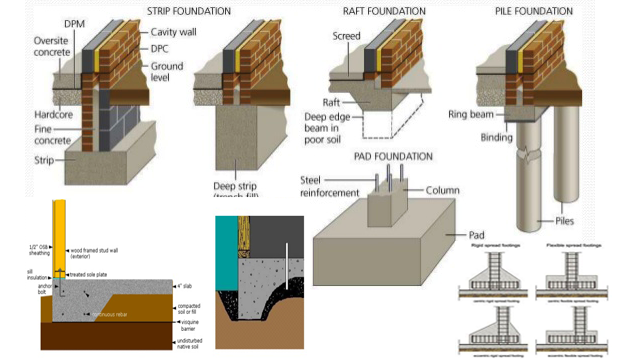
Different types of foundation and their usefulness

Maximum structures are built with two parts like super structure and sub-structure of the foundation. Super Structure is located over the ground and the other sub-structure of the foundation is located beneath the ground level. Foundation alias footing of a structure associates and transfers the load from the structure to the ground soil. The foundation is developed on the solid ground and it is called as the foundation bed. The foundation transfers the load of the structure and it?s self-weight to the soil with the purpose of keeping the final bearing capacity of the soil under control (the shear failure does not occur) as well as keeping acceptable settlement.
All the structures have foundation at the base that offers the following functionalities:
- To disperse the load of the structure across an extensive bearing area.
- To load the bearing surface equally to get rid of asymmetrical settlement.
- To resist the lateral movement of the supporting material.
- To enhance the strength of the structure all together.
Foundation is based on the following points :-
Foundation is categorized depending on the dispersion of load to the ground into two sub-categories like shallow foundation and deep foundation.
Shallow Foundation
Shallow foundation belongs to the foundations where depth of the foundation remains below the width of the foundation (D < B). Shallow foundations are usually known as spread footing because they transfer the load of the super structure laterally into the ground.
Categorizarion of Shallow Foundation:
Based on the design, the shallow foundation is classified as:
- Wall Footing
- Isolated column or Column Footing
- Combined Footing
- Cantilever (Strap) Footing
- Mat (Raft) Foundation
- Wall Footing
This type of foundation runs consistently along the direction of the wall and facilitates transferring load of the wall into the ground. Wall footing are mostly applicable where transferrable loads are small and cost-effective in compact sands and gravels. For this type of foundation, the width remains 2-3 times the width of the wall at ground level. Wall footing is built up with stone, brick, plain or reinforced cement concrete.
Column Footing
Column footing are useful and inexpensive for the depth surpassing 1.5m. For this type of foundation, the base of the column is distended. Column footing comes in the shape of of flat slab and is developed with plain or reinforced concrete.
Combined Footing
Combined footings belong to the foundations which are built in common for two or more columns in a row. It is generally formed if the footing for a column is spreaded outside the property line. It is applicable if the two columns are placed narrowly and the soil on which the structure is developed contains low bearing capacity. The shape of the combined footing appears as rectangular or trapezoidal.
Strap Footing
If an edge footing fails to spread outside the property line, it is connected with the other interior footing through a strap beam. Such footings are defined as strap footing. or sometimes cantilever footing.
Mat Foundation
A mat foundation belongs to a combined footing that covers the whole area below a structure and supports all the walls and columns. It is also called as raft foundation. Mat foundation is mostly suitable for the following reasons:
Permissible bearing pressure is low.
The structure is weighty.
The site is located with highly compressible layer.
The mat foundation is categorized into following types:
Flat slab type.
Flat Slab thickened under column.
Two way beam and slab type.
Flat slab with pedestals.
Rigid frame mat.
Piled mat.
To read the complete article, visit www.civileblog.com/foundation-types/#Column_Footing


